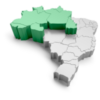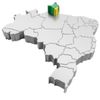Tragedy on Mount Rinjani: The Confirmed Death of Juliana Marins and Its Lessons for Adventure Tourism
Tragedy on Mount Rinjani: The Confirmed Death of Juliana Marins and Its Lessons for Adventure Tourism
Portal Visitar Brasil strives to go beyond beautiful images, revealing critical truths about the hidden dangers of traveling. Brazilian hiker Juliana Marins, 26, from Niterói (RJ), was confirmed dead on June 24, 2025, after falling some 600 m (~1,968 ft) down a cliff on Mount Rinjani, Indonesia, and remaining injured and unreachable for four days in steep, foggy terrain yahoo.com+5amp.cnn.com+5abcnews.go.com+5.
 Incident Timeline
Incident Timeline
| Date | Event |
|---|---|
| June 21 | Juliana begins the Mount Rinjani trek with a guide and five others. She slips and falls off a ridge early morning abcnews.go.com+4amp.cnn.com+4yahoo.com+4. |
| During next 4 days | Tourists and rescuers search under extreme conditions using thermal drones, but terrain and dense fog hinder attempts. |
| June 24 | Drone footage locates Juliana’s body. Indonesian SAR confirms no signs of life; death confirmed . |
| June 25 | Rescuers take over 5 hours to carry her body on stretchers through treacherous terrain to Sembalun basecamp . |
| Diplomacy & Repatriation | Brazil’s embassy coordinates with local authorities. Family recognizes her remains. Repatriation is family’s responsibility, per Itamaraty . |
 Key Takeaways for Adventure Travel
Key Takeaways for Adventure Travel
-
Extreme terrain + poor visibility complicate rescues
Rugged cliffs and fog can delay rescue by days—even when drones locate victims. -
Thermal drones help locate, not recover
Finding a person is only half the battle; extraction on foot remains arduous. -
Always use emergency trackers and radios
Relying exclusively on mobile signals or group presence is risky. -
Tour claim ≠ full safety
Guides and local agencies aren’t magicians; limited equipment and local protocols can restrict rescue. -
Invest in proper rescue coverage
Standard travel insurance rarely includes mountain rescue or evacuation; verify before booking.
 Updated FAQ
Updated FAQ
| Question | Answer |
|---|---|
| Could she have survived longer? | Being trapped for four days in steep, exposed terrain made survival nearly impossible. |
| Who led the rescue mission? | Basarnas (Indonesia’s National Search and Rescue Agency), assisted by drones and mountain teams skynews.com.au+4amp.cnn.com+4theguardian.com+4. |
| When was the body retrieved? | June 25, after a five-hour ground operation. No helicopters due to foggy conditions . |
| What about repatriation? | Handled by the family, as per Brazilian consular guidelines . |
 Essential Tips for High-Risk Adventures
Essential Tips for High-Risk Adventures
-
Always share your route with family and use a GPS tracker or satellite communicator.
-
Purchase robust insurance covering mountain rescue and medical evacuation.
-
Choose agencies with real SAR gear and protocols—not just tour liability.
-
Avoid treks when weather is unstable—fog and rain can drastically reduce safety.
-
Stick to official trails—unmarked paths often lack proper support or rescue access.
 Final Thoughts
Final Thoughts
Juliana Marins’ tragic end is a sobering reminder that nature offers no guarantees. Whether facing snow-capped peaks or volcanic craters, responsible preparation, reliable equipment, and a healthy respect for environmental risks are essential. If you’re drawn to intense adventures like Rinjani, prioritize safety over the thrill—your life depends on it.
 SEO TAGS (25)
SEO TAGS (25)
adventure tourism, Mount Rinjani, Juliana Marins, Indonesian volcano, mountain rescue, volcanic crater fall, hiking safety, Basarnas rescue, thermal drone, travel insurance adventure, trekking accident, foggy terrain, medical evacuation, family repatriation, risky trail, guide limitations, emergency tracker, mountain weather, Indonesia trekking, slope fall, outdoor preparedness, remote rescue, consular assistance, steep terrain hazard, responsible travel










































































 )
)







 Caldas Novas – Goiás
Caldas Novas – Goiás 
















